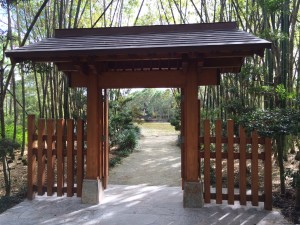As we began the walk through the well-manicured pathways, the first thing that came to mind was the skillfulness that was required to create such a masterpiece.
 I was immediately taken by the stunning use of space—not emptiness, but space with the sense and feel of dimension. The spaces were designed to allow those walking through to be creative and experience emotion and movement from their own perspective. The space was evident in the overall design, but it was also present in every one of the exquisitely crafted “garden rooms,” from the smallest detail of each individual plant, to well-placed art, rocks, benches, and water elements.
I was immediately taken by the stunning use of space—not emptiness, but space with the sense and feel of dimension. The spaces were designed to allow those walking through to be creative and experience emotion and movement from their own perspective. The space was evident in the overall design, but it was also present in every one of the exquisitely crafted “garden rooms,” from the smallest detail of each individual plant, to well-placed art, rocks, benches, and water elements.
The walking experience came about from the opportunity to stroll through the Morikami Museum and Gardens while at a conference in Southern Florida. The gardens and museum were on land donated by George Sukeji Morikami who wished for it to become a park to preserve the memory of a group of Japanese farmers who formed the Yamato agricultural colony in Southern Florida in the early 1900s. Today, visitors stroll through sixteen acres of authentic Japanese gardens and rotating exhibitions of Japanese art in the museum’s galleries. The museum is the nation’s only museum dedicated to Japanese living culture, and its gardens are recognized among the finest outside Japan.
I always listen to what I can leave out.
~ Miles Davis
 Open space manifests all of the principles that make up the essence of Japanese design. In fact, all great artists use space as an important element in their art making. Artists have the ability to create without filling every space—visual and time “legroom” so to speak. This aspect of artistic expressions is one of the most important factors of effective creative expression. It shows respect for the artist’s audience—allowing the viewer or listener to become a part of the work of art, free from the sense of being closed in to a certain perspective.
Open space manifests all of the principles that make up the essence of Japanese design. In fact, all great artists use space as an important element in their art making. Artists have the ability to create without filling every space—visual and time “legroom” so to speak. This aspect of artistic expressions is one of the most important factors of effective creative expression. It shows respect for the artist’s audience—allowing the viewer or listener to become a part of the work of art, free from the sense of being closed in to a certain perspective.
Certainly, there is room for more space and silence in the complex world we live in today. Think about conversations, our living and working environments, and the presence of digitized sound in nearly everything we do. Silence and space give way for everything to take on deeper meaning.
 Beyond gardens, design, art, and music, space and silence can also be used in the design of our lives. The right amount of space and silence in our daily lives can have a profound impact on the way we think, on our relationships, and on the actions we take.
Beyond gardens, design, art, and music, space and silence can also be used in the design of our lives. The right amount of space and silence in our daily lives can have a profound impact on the way we think, on our relationships, and on the actions we take.
Space is the breath of art.
~ Frank Lloyd Wright
 Space allows balance and permits us to focus on what’s most important. It gives us a feeling of peace that we can’t achieve with the overcrowding that most of us experience on a daily basis. The breathing room built in to the design of the Morikami Gardens has tremendous power. The experience gave me an important reminder of the value of those artistic qualities in art but also the value of space and silence in adding a special quality to life.
Space allows balance and permits us to focus on what’s most important. It gives us a feeling of peace that we can’t achieve with the overcrowding that most of us experience on a daily basis. The breathing room built in to the design of the Morikami Gardens has tremendous power. The experience gave me an important reminder of the value of those artistic qualities in art but also the value of space and silence in adding a special quality to life.
-Pat
